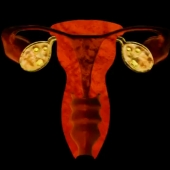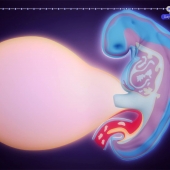In preparation for birth, your baby is now upside down in your uterus unless he's breech. Not to worry, if he is breech, there's still time for him to turn around before you deliver. Your doctor may even be able to perform some techniques to help him move into the proper position for a vaginal delivery.
Your baby is gaining lots of weight to fill out his wrinkly sooth of skin. By week 39, he had shed most of that white creamy substance called vernix and fine fur-like hair called lanugo that has covered his skin since the middle of your second trimester.
Because he's running out of room in our uterus he mostly stretches and wiggles. Now that he weighs around 6 pounds, he doesn't have room to give you a big kick which might be a welcome change.
When your baby is in the upside down position her head will rest against your cervix which is busy opening or dilating so that she can past through the birth canal. She's been cramped in your uterus for the last couple of months, but that's nothing compared to the tight squeeze ahead.
Once you start having contractions and going to labor, the walls around her will tighten and your cervix will dilate around her head. The bones in her skull aren't fuse together yet so they can move and make her passage out a little easier.
The warm comforting amniotic fluid bath that had surrounded her for the last 9 months will slowly leak out once your water breaks. With every contraction her head is forced against your cervix.
After her head passes your cervix and enters your birth canal, she begins to make twisting movements to help her navigate through your vaginal canal. She starts out facing left or right but most eventually turn face down or sometimes face up as she moves toward the vaginal opening.
Your last push expels her from your birth canal. She'll be attached to you until your doctor or partner cuts the umbilical cord as she takes her first breath of air. She might start to cry. Congratulations Mom, it's time to finally meet your baby.
- 649 views













